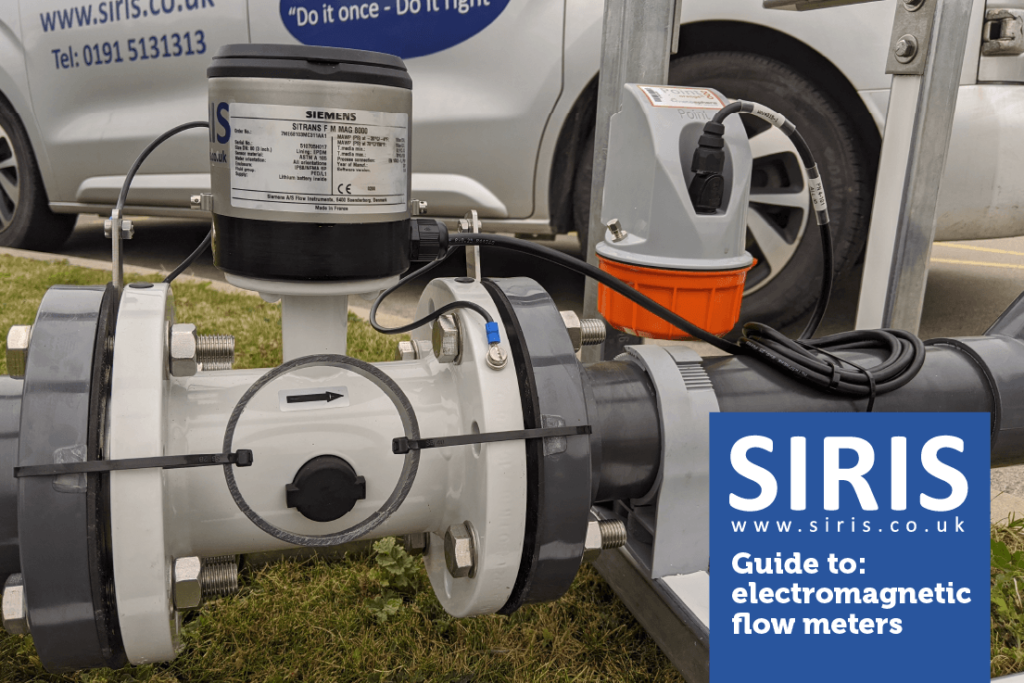The electromagnetic flow meter (or ‘magmeter’) is a popular, highly accurate and low maintenance flow measurement option for closed pipe applications. In this guide we explain what they are and how they work.

What is an electromagnetic flow meter and how does it work?
Electromagnetic flow meters are of the most widely used wastewater flow measurement options for closed pipe applications due to their high level of accuracy and reliability, when installed and maintained by a qualified engineer. The instruments work by measuring the voltage produced by a conductor (i.e. wastewater) moving through a magnetic field, following the principles of Faraday’s Law.
Faraday’s Law
Faraday’s Law of Induction predicts how a magnetic field will interact with an electric circuit to produce an electromotive force (EMF) – a phenomenon known as electromagnetic induction. The more conductive a fluid is the better it will be reflected in the readings, which makes magmeters suitable for wastewater applications. In an electromagnetic flow meter, a magnetic field is generated and channelled into the liquid flowing through the pipe.
Faraday’s Law states: “The electromotive force around a closed path is equal to the negative of the time rate of change of the magnetic flux enclosed by the path.”
So in simple terms, when the liquid moves faster, more voltage is generated. The voltage signal is detected by electrodes in the sensors and the velocity is calculated. By knowing the diameter and hence the area through which the liquid is passing and multiplying this area by the velocity detected, flow rate is calculated.
Benefits of electromagnetic flow meters
- Minimal pressure drop – magmeters can be an ideal solution for wastewater applications that require a low maintenance solution without pressure drop as they can provide an unobstructed flow path when installed
- Low maintenance – as there are no moving parts they can be very robust and a good solution for pipes which are difficult to access, however there should still be a regular schedule of maintenance where the internal pipe bore is cleaned and inspected
- Highly accurate – typically between ±0.25% or 0.5% of rate (depending on model)
- Space requirements – an electromagnetic flow meter requires a straight uninterrupted approach length of 10 x the diameter, although a minimum of 5 x diameter can be acceptable
Alternative solutions
Provided the conditions are right, a clamp-on ultrasonic flow meter can be a convenient and affordable alternative. This type of flow meter can be installed without cutting the pipe and therefore simplifying installation. Ideally, this type of flow measurement needs a greater upstream straight length of pipe than a magnetic flow system and can be less tolerant of detecting flows where there is entrained air or where solids are deposited on the internal pipe wall.
Read our guide to ultrasonic flow meters to learn more about this flow measurement technology.
Electromagnetic flow meter installation and maintenance
Electromagnetic flow meters are often labelled a “fit and forget” solution due to their high reliability in giving good long term accurate flow data with low maintenance requirements.
The lack of moving parts on this type of flow meter means it is a robust and easy-to-maintain solution that rarely breaks down, however we do still recommend occasional (but regular) servicing to ensure it is working to optimum standards.
The design of an installation should take into account access for maintenance such as cleaning/rodding or inspecting the inside of the pipe and sensor, for removal of the sensor and for the installation of a verification flow instrument.
Quite often flow systems, especially where MCERTS certification is required can be compromised by the installation design being poor and as such the design should be undertaken by someone with the necessary skills and knowledge. Unfortunately this often means the absolute minimum design conditions are suggested, and while this might initially seem cost effective, it usually results in a new flow measurement system having the worst acceptable conditions and being less tolerant of error or other system variations.
Talk to the experts
Our team of experts have can offer advice and guidance on the best type of flow meter for your requirements. We encourage you to get in touch to find out how we can help on hello@siris.co.uk.